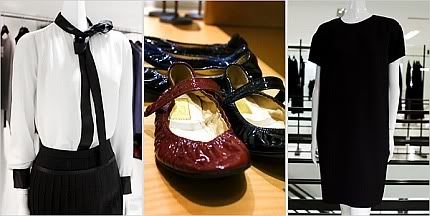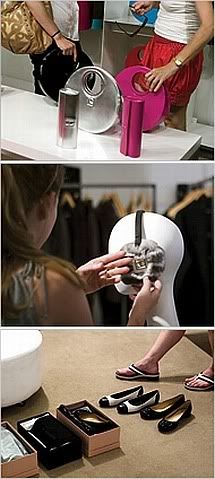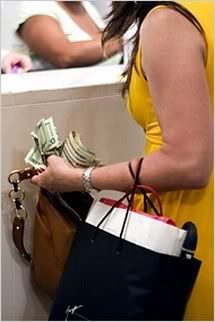Cuando el precio alto es la "carnada".
FASHION & STYLE |
| When High Price Is the Allure By RUTH LA FERLA Published: August 9, 2007 |
|
|
| WHEN readers leaf through the September issue of Vogue, which arrives on newsstands next week, they will encounter a Prada mohair twin set tagged at $2,925; a chunky Giles sweater, at $3,675; and a supersize Marc Jacobs bracelet, at $2,180. And as fall looks begin trickling into stores this month, shoppers will find basic designer sheath dresses selling for $1,200, coats for just under $4,000 and designer sunglasses for $500 or more. This is the fourth consecutive autumn season in which a weak dollar has meant higher prices for designer clothing, much of which is made in Europe or stitched from fabrics imported from European mills. As the value of the dollar shrinks against the euro, prices continue to climb, with retailers citing hikes of as much as 15 percent for shoes and bags this year compared with last. Yet, merchants and manufacturers have seen surprisingly little resistance in recent seasons to the cost of luxury goods. So strong is the demand for cashmere car coats and crinkled patent leather bags at Barneys New York that that two firms — one from Dubai, the other from Japan — are in a bidding war this month to acquire the store for close to $1 billion. The luxury conglomerate LVMH, the owner of Louis Vuitton, had net profits for the first half of 2007 of $1.11 billion, up 2 percent from a year ago. Profits at the parent of Gucci and at Prada are also up. Those brands owe part of their success to shoppers with caviar taste who have come to view extravagant prices as an enduring, if unwelcome, fact of life. At the same time, another consumer cohort is driving the trend, shoppers for whom a high ticket can in itself be an inducement to buy. Just as makers of premium ice cream have persuaded consumers to pay $4 for a cone instead of 90 cents, and California vintners convince them that a $100 cabernet is better than a $50 bottle, the makers of designer clothing know that high prices can cast a spell. "Price certainly plays into a product's allure," said Robert Burke, a retail consultant in New York. "For certain people, the higher the price, the more attractive the item becomes." |
|
|
| An exorbitant price can confer exclusivity. "People are willing to pay a significant amount of money to make sure they don't see their purchase on other people," Mr. Burke said. Or to ensure that their friends will recognize its provenance. "Price is part of the status of certain luxury items," said Marvin Traub, a retail consultant in New York. Mr. Traub, who visited Moscow in March, noticed that people there were fascinated not by how little but how much was paid. To some extent, Mr. Traub noted, "that sort of thinking translates here, too." Among merchants and manufacturers, consumer psychology can be as significant as economics in setting prices. "Luxury makers are not necessarily forced to raise prices above the exchange-rate factor, but sometimes they do," said Milton Pedraza of the Luxury Institute, a research group in New York. "Why? They know that consumers are resilient. For manufacturers, it's really about asking for a price increase because you can." Those remarks resonate with Jeffrey Kalinsky, a specialty retailer who owns fashion emporiums in New York and Atlanta. Mr. Kalinsky, who is also the director for designer merchandizing of Nordstrom, does not pretend to speak for his customers. But he shares their sometimes-irrational passions. He recalled that as long as 20 years ago, when he was in his mid-20s, he would "just walk into a store and see a sweater, and something inside of me would say, 'Oh, I hope I can afford it. I bet it's at least $800.' "That sweater would be $1,100," Mr. Kalinsky confided, "but, miraculously, then I would want it more." In some cases, manufacturers adjust prices upward to make sure that their goods hang in good company, displayed alongside prestigious luxury brands. "They tack on a healthy premium, because they want to maintain the exclusivity of the brand," Mr. Pedraza said. "The customer pays for that cachet." Susan Sokol, the president of Vera Wang, acknowledged that while it is important to maintain a range of prices within a collection, "it is extremely critical to understand price positioning and to be very strategic about it. "If I know our customer is buying Miu Miu or Dries van Noten," she said, "we have to price accordingly." The appetite for high-end wares has been a boon to retailers, who need to sell fewer of a given item to turn a handsome profit. The higher the price, the higher the margin, Mr. Burke pointed out: "It's much easier to sell five of something really expensive than 20 of something less expensive." Markups, he said, have remained much the same since last year. |
|
|
| A stroll through several high-end stores in Manhattan this week turned up prices that might be the equivalent of a down payment on a minivan. At Jeffrey, in the meatpacking district, a raglan-sleeve black jersey Lanvin dress was $2,455, a Shawn Collins thermal knit sweater $995. Barneys offerings included a Balenciaga leather bag with fancy grommets, $1,725; Lanvin leather ballet flats, $530; and Marc Jacobs cuffed leather ankle boots, $995. At Bergdorf Goodman, a Stella McCartney turtleneck devoid of trim sells for $995, and her cable-stitched sweater for $1,495. A pair of Kieselstein-Cord sunglasses is tagged at $595. Far from daunting, such a ticket might be downright seductive to customers, Ms. Sokol said. "When you are looking at a handbag or even a pair of sunglasses, a high price can have inherent snob appeal." Consumers tell themselves, Ms. Sokol went on, " 'If those glasses are $150, I'm not going to be as interested as if they are $350.' " That is not to say that consumers are indifferent to price. Many are making emotional adjustments, finding ways to balance a love of fashion with the reality of its increasingly exorbitant cost. Eunice Ward, a lawyer in Chicago with a taste for quirky labels like Dolce & Gabbana and Stella McCartney, pays full price only for items that resonate with her sense of style. During a recent shopping trip, she spied a Yohji Yamomoto sweater. "I knew it would fit with my wardrobe and update everything," she said, "that it was going to be my workhorse for fall. "I didn't even check the price at first. I knew I would love it, and I didn't care." At Saks Fifth Avenue in Manhattan last week, Jessica Lee darted among the racks, gazing avidly at a champagne-colored Miu Miu cocktail dress, scarcely bothering to look at its $1,250 tag. "Fashion's gotten more expensive," Ms. Lee said, a fact as inevitable, and untroubling, to her as the tide. "The economy is good," said Ms. Lee, who works for a private equity firm in Manhattan. "I've made a lot more over the past year than before, and so I have more purchasing power." Kate Strachan appeared to be more circumspect. As a technical designer for a fashion house, she is well acquainted with the price of style. "I know a lot of quality, craftsmanship and time goes into some of these pieces," Ms. Strachan said. Regardless, she is determined to put a cap on her spending. Combing the racks at Saks, she sighed wistfully: "I can't afford these kinds of things, so usually I buy what I need most. This year that would be a winter coat." Then with a self-mocking smile she added, "Of course there are times when I'll splurge." |




0 Comments:
Post a Comment
Subscribe to Post Comments [Atom]
<< Home